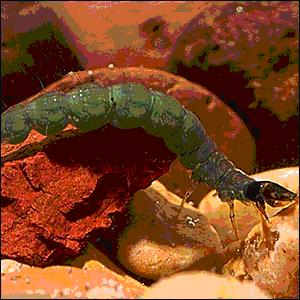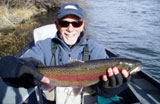Description
Anyone who has turned over rocks in
freestone streams has seen the abundant,
small green, dark-headed worms that make
such places home. Here is a good image of a
specimen:
Arlen Thompson photograph:

The technical name for genus of this bug is
Rhyacophila. Note several characteristics of
this larva: its pronounced segmentation; its
green color, and the fact that it has no
case (“free-living”). They inhabit riffled
water, similar to the water preferred by
stoneflies. They are often found in the
drift through either accidental event
(washed away from a rock) or behavioral
drift, where a large number of larvae will
detach themselves from the rocks and drift
to another part of the river. This behavior
occurs at times in mid-morning and
afternoon. Hatches occur in late morning or
early afternoon, in my experience, from May
through August.
Trout will graze on the drifting insects
during these times. The hatching pupae are
eaten in large numbers by trout during the
hatch. Adults live for a couple of weeks,
returning to the water where the females
swim to the bottom of the stream and deposit
their eggs. The adults are vulnerable to
trout when they land on the water; when they
swim to the bottom to deposit eggs; and when
they again swim to the surface. Like all
caddis, Rhyacophila go through a pupation
period before hatching. They seal themselves
inside a small chrysalis made of rocks and
sand (called “periwinkles) by some.
This month’s fly represents one way to
create a nice imitation of this insect’s
larva stage. There are other ways—just do a
Google search on “green rockworm” and you’ll
find a wealth of information on the bug and
on suitable imitations. I like the furled
version since it is simple to tie, and it
moves in the water in an enticing manner.
See the GBF Fly Pattern Archive for another pattern from the GBF
Fly Archive
Tying Instructions
|
|
|
1.
De-barb the hook.
2.
Tie the thread
onto the hook just behind the eye, and move it rearward about one sixteenth of
an inch.
3.
Using a very
small amount of dark green antron yarn, furl a body that is about one-half inch
in length. The body should be very slender. For a tutorial on the furling
process, see my “At the Vise” column in the March-April issue of
California Fly Fisher magazine.
4.
Tie the furled
body to the shank where the thread was previously left and trim the excess yarn.
5.
Dub a small head
with relatively fine dark brown dubbing. Whip finish and trim the thread. |
|
|
Tying & Fishing Tips
1.
Fish this critter near the bottom during behavioral drift time, or during the
first part of the hatch… |
|
|

|
|
|

